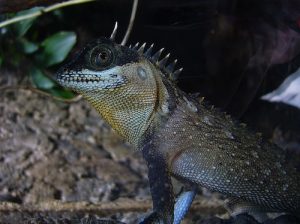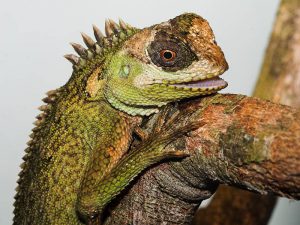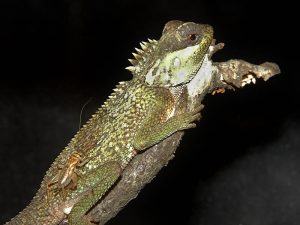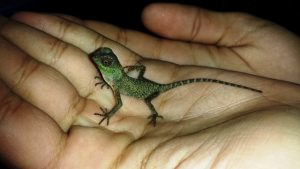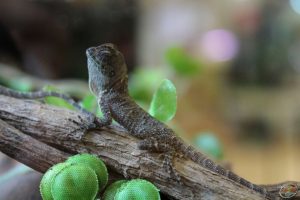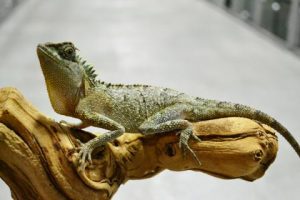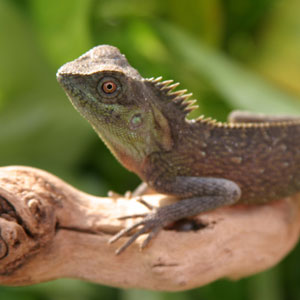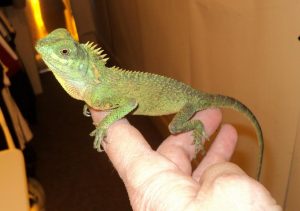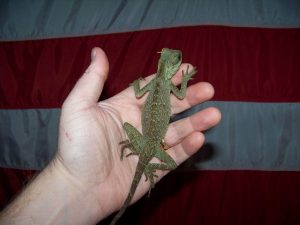Mountain Horned Lizard: Unique Reptile with Fascinating Behaviors and Adaptations
In the dense forests of Southeast Asia, the Mountain Horned Lizard is a master of disguise. With its spiny head and scales designed for camouflage, this reptile moves silently through the foliage, waiting patiently for its next meal. Known for its incredible adaptations and unique behaviors, the Mountain Horned Lizard captivates not only scientists but reptile enthusiasts around the world.
The Arboreal Predator of Southeast Asia
The Mountain Horned Lizard is a fascinating species native to the dense forests and hillsides of Southeast Asia, including regions of Thailand, Vietnam, and Cambodia. This arboreal lizard is often found perched on branches or nestled among the low vegetation of its forest habitat. With its large eyes, sharp spines, and vibrant colors, it is well-equipped to blend into its surroundings and avoid predators. The Mountain Horned Lizard has adapted to its environment with remarkable features, making it a true survivor in the wild.
Scientific Classification
| Kingdom | Animalia |
| Phylum | Chordata |
| Subphylum | Vertebrata |
| Class | Reptilia |
| Order | Squamata |
| Suborder | Iguania |
| Family | Agamidae |
| Subfamily | Draconinae |
| Genus | Acanthosaura |
Physical Characteristics: Adapted for Camouflage and Survival
The Mountain Horned Lizard is a medium-sized reptile, typically measuring between 10-12 inches in total length, with its tail sometimes longer than its body. The most striking feature is its spiny crest running along the back of the neck, resembling a crown or a “horn,” giving this lizard its name. Its coloring varies from olive brown to light green, providing effective camouflage against the forest floor or branches. These scales are not just for show; they help protect the lizard from predators and act as a deterrent.
- Size: 10-12 inches long; tail length equals or exceeds body length
- Color: Olive green to brown on the back, light brown, green, or reddish underside
- Distinctive Features: Large eyes, spiny head, and dorsal spines
- Lifespan: 5-8 years in captivity
The Mountain Horned Lizard’s adaptability and defensive features make it a formidable creature in its forest habitat.
Species
There are 11 species within the genus, some of which are A. armata, A. coronata, A. brachypoda, A. cardamomensis, A. capra, A. lepidogaster, and A. crucigera.
Quick Information
| Other Names | Pricklenape agamas, Scale-bellied Tree Lizard, Brown Pricklenape |
| Size | 10-12 inches; tail length is equal to or greater than its snout-to-vent length |
| Color | Olive green/brown back; light brown, green, or reddish underside |
| Distribution | Burma, Cambodia, Indonesia, Vietnam, Lao PDR, Thailand, Malaysia, China (Yunnan, Hainan, Guangxi, Fujian) |
| Habitat | Dense canopies of primary forests, occasionally near streams; also lives in areas with low vegetation |
| Lifespan | 5-8 years (in captivity) |
| Diet | Insectivorous reptiles; feeds on mealworms, silkworms, moths, grasshoppers, roaches, crickets, earthworms, wax worms, and moths; captive lizards are also provided with minnows, goldfish, and newborn mouse |
| Adaptations | Large spines on its nape are used to deter predators; when it feels threatened, it moves swiftly to evade the attacker; some species of horned lizards change colors to conceal themselves |
| Diseases | Metabolic bone disease, fungal dermatitis, diseases caused by parasites such as coccidia and pinworms, snout damage, egg binding, respiratory infections |
| Clutch | 10-16 eggs |
| Incubation Period | 140-190 days |
| Predators | Snakes, hawks, wolves, coyotes, roadrunners |
| IUCN Conservation Status | Least Concern |
Diet and Hunting: Sit-and-Wait Strategy
As an insectivorous reptile, the Mountain Horned Lizard primarily feeds on insects like mealworms, silkworms, grasshoppers, and moths. The lizard uses a “sit-and-wait” strategy to hunt. It perches motionless on a branch, often two meters off the ground, patiently watching for prey below. When an insect comes within range, the Mountain Horned Lizard pounces, using its quick reflexes to capture it.
Diet Includes:
- Insects: Mealworms, silkworms, moths, grasshoppers, crickets
- Occasional Additions: Earthworms, roaches, minnows, and goldfish
Its patient hunting style and ability to stay motionless for long periods make it an expert ambusher, maximizing its energy efficiency while waiting for food to come within reach.
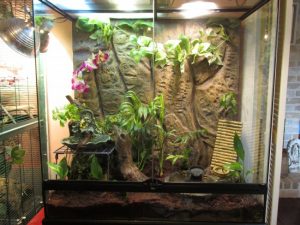
Mountain Horned Lizard Cage
Behavior: Territorial and Adaptable
The Mountain Horned Lizard is a territorial species, especially in the wild. It does not tolerate the presence of other males in its area and will defend its space aggressively. During courtship, males perform displays, extending their gular sacs and bobbing their heads to attract females. These reptiles are also quite active during the day, spending time in the trees and low vegetation, often basking in the sun or hiding to avoid larger predators.
- Territorial Nature: Males aggressively defend their space
- Courtship Displays: Male displays include extending their gular sacs and head-bobbing
This territorial behavior ensures that each lizard has access to the resources it needs to survive, including shelter, food, and mates.
Reproduction and Life Cycle: A Careful Mating Process
The Mountain Horned Lizard begins its breeding season in July, when males compete for the attention of females. Males perform a series of courtship rituals, including head-bobbing and showing off their colorful gular sacs. Once mating occurs, the female digs a burrow, laying a clutch of 10-16 eggs after a gestation period of about 4 months. The eggs incubate for 140-190 days, depending on environmental conditions.
- Mating Season: Begins in July, males compete for mates
- Clutch Size: 10-16 eggs per female
- Incubation: 140-190 days
Hatchlings emerge at 2.5-3.5 inches in length and begin to grow rapidly. By 1.5 years, they reach sexual maturity, ready to begin the cycle again.
Life Cycle
The babies emerge from the eggs after the incubation period. The hatchlings measure 2.5-3.5 inches in length and weigh around 1-2 grams. The juvenile lizards grow, becoming sexually matured at about 1 ½ years of age.
Conservation and Challenges: Protecting the Mountain Horned Lizard
The Mountain Horned Lizard is currently classified as “Least Concern” by the IUCN, but it faces challenges in the wild. Habitat loss due to deforestation and the illegal pet trade threaten the species. In the wild, these lizards must contend with predators such as snakes, hawks, and other birds of prey. Additionally, they are susceptible to various diseases, including fungal dermatitis and metabolic bone disease, especially in captivity if not properly cared for.
Conservation Challenges:
- Habitat Loss: Deforestation and land use change
- Pet Trade: Harvesting for the exotic pet market
- Health Issues: Diseases like fungal dermatitis and bone disease
Efforts to protect the Mountain Horned Lizard include habitat restoration, sustainable pet trade practices, and education on proper care for captive animals.
Interesting Facts
- Acanthosaura capra is the most popular, easily kept, and the hardiest mountain horned lizard species encountered in the American pet trade.
- Some Acanthosaura species such as capra change colors with mood. When stressed they get very dark, and when sleeping their body becomes yellowish.
- These lizards are also known to hunt fish without submerging their heads.
- Mountain horned lizards cannot tolerate extreme heat. In captivity, special care must be taken so that the air temperature within their terrarium remains around 80° F while the humidity should be 70-75 percent.
Summary: A Fascinating Arboreal Lizard with Unique Traits
The Mountain Horned Lizard is a remarkable reptile, blending beauty, agility, and resourcefulness. From its territorial behavior to its unique hunting strategy, it continues to fascinate both scientists and reptile enthusiasts. While it faces challenges from habitat loss and illegal trade, the Mountain Horned Lizard remains a resilient survivor in its native habitats. With ongoing conservation efforts, we can ensure that this fascinating species continues to thrive in the wild.
References
- https://en.wikipedia.org/wiki/Acanthosaura
- https://www.lllreptile.com/articles/46-mountain-horn-lizard/
- http://www.kingsnake.com/mhd/MHDkingsnake.html
- https://www.exotic-pets.co.uk/mountain-horned-dragon.html
- https://www.iucnredlist.org/species/170366/111992615
Published on May 26th 2016 by admin under Coniferous Forest Animals.
Article was last reviewed on 10th December 2024.


